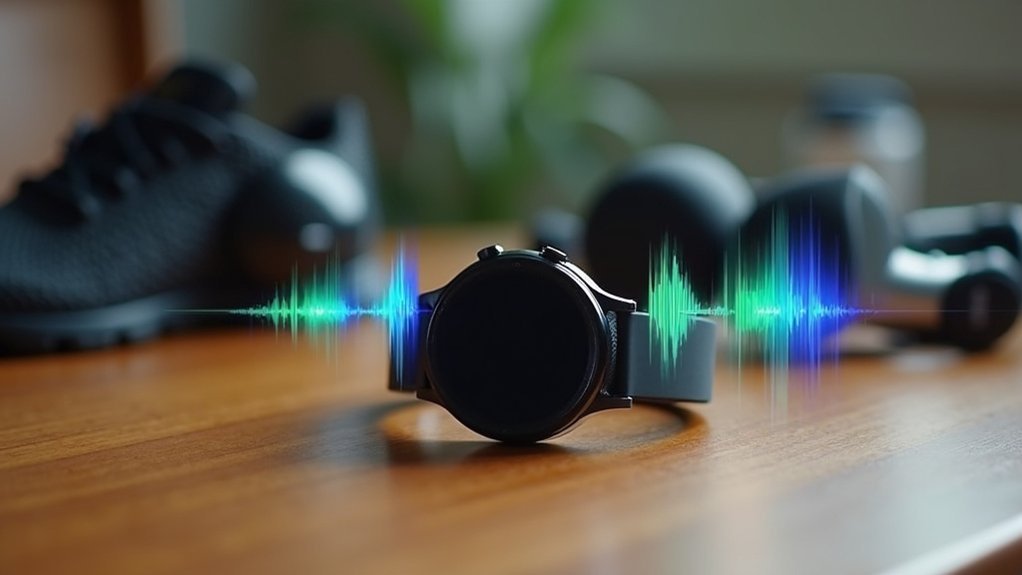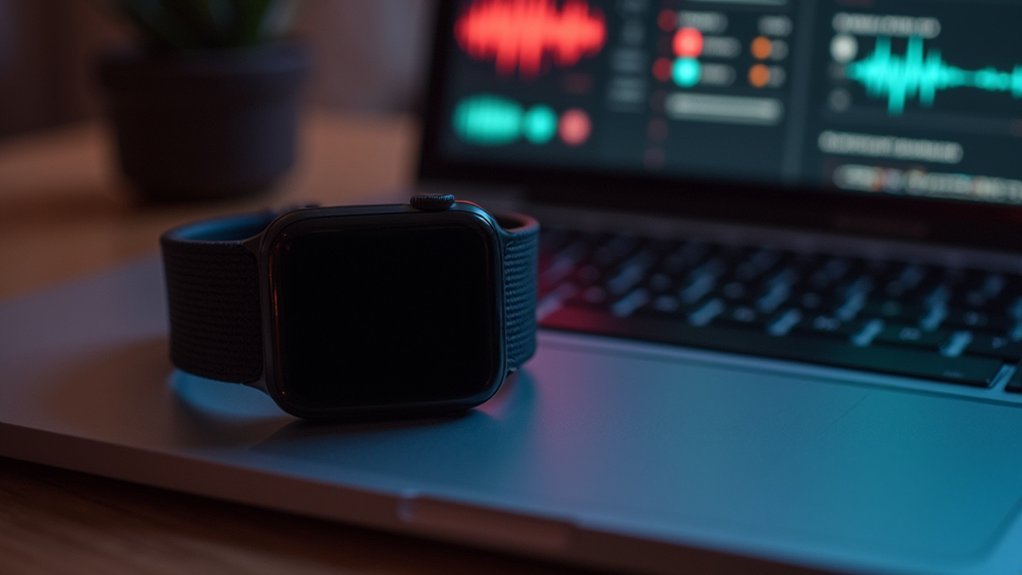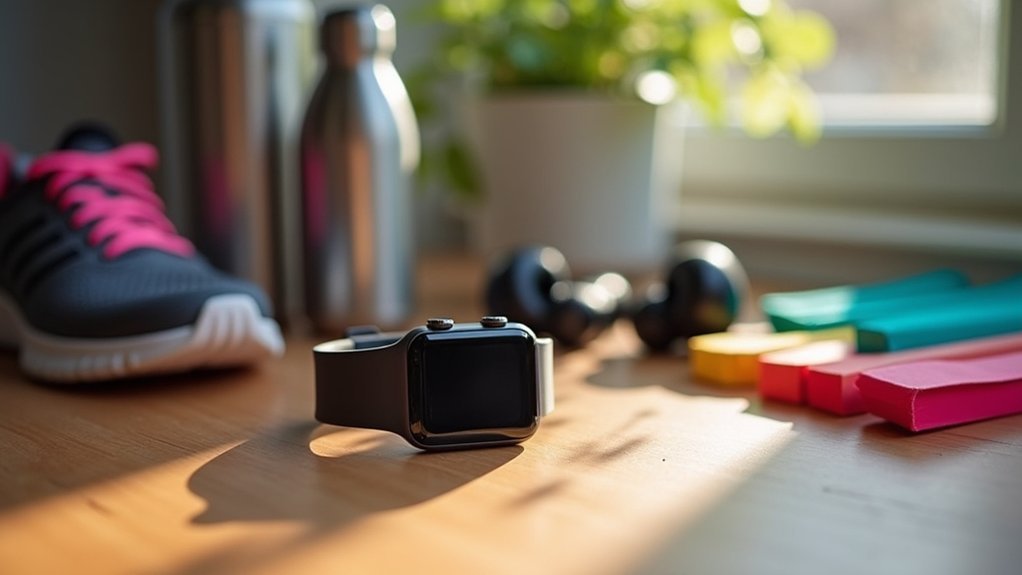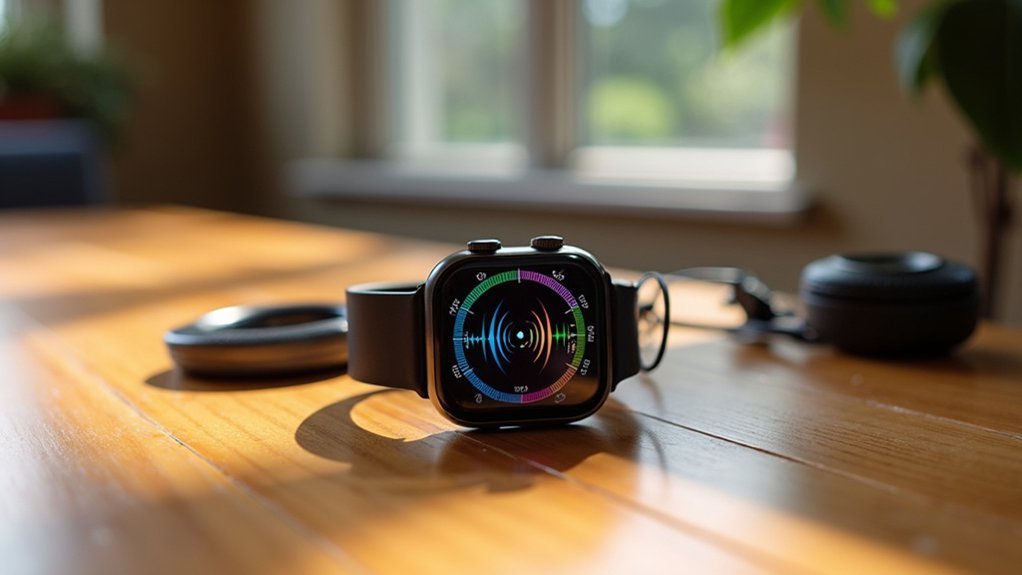You can customize your sport watch alert sounds by accessing the sound settings through your watch’s menu or companion app. Set unique notification tones for different apps, create personalized vibration patterns with varying intensity levels, and configure event-based alerts for workouts and activities. Use separate volume controls for ringtones, notifications, and media, while setting up “Do Not Disturb” modes for silent hours. Audio prompts can provide real-time feedback during fitness sessions. These foundational steps reveal your watch’s full personalization potential.
Understanding Your Sport Watch Sound Customization Options

Most sport watches offer three primary sound modes that let you control how alerts reach you during different activities. You can choose between Sound, Vibrate, and Mute modes depending on your environment and workout type.
Sound mode delivers auditory alerts, while Vibrate provides tactile feedback that’s perfect for noisy gyms or quiet spaces where you don’t want to disturb others.
You’ll find separate volume controls for different alert types – ringtones, notifications, system sounds, and media playback each have independent settings.
This means you can silence button clicks while keeping call alerts active. Many watches also let you combine vibration with sound alerts for maximum notification reliability during intense workouts when you might miss a single alert type. When connected via Bluetooth, your sport watch may unexpectedly play audio from media apps, so accessing your Bluetooth settings to toggle off audio options can prevent unwanted sound playback during workouts.
Setting Up Custom Notification Sounds for Different Apps
You’ll want to assign unique sounds to different apps so you can instantly recognize whether that buzz is a text, email, or fitness reminder.
Beyond custom sounds, you can set up distinct vibration patterns and configure priority filtering to guarantee important notifications break through while less critical ones stay subtle. The process involves using a file explorer app to transfer your chosen audio files to the watch’s notification folder for proper integration.
These personalized alert systems help you stay connected without constantly checking your watch face during workouts or daily activities.
App-Specific Sound Assignment
Setting up custom notification sounds for different apps transforms your sport watch experience from generic beeps to personalized audio cues that instantly tell you what needs attention.
However, app-specific sound customization varies considerably across devices and platforms.
Android and iOS smartphones offer extensive notification sound customization, letting you assign unique sounds to messaging apps, email clients, and social media platforms. You can even use music files as notification tones by storing them in designated folders.
Unfortunately, many smartwatches, including Galaxy Watch models, don’t currently support app-specific sound assignment. Your watch typically forwards notifications from your connected phone without custom sound differentiation. To modify notification sounds for individual apps, access the Settings app and navigate to the specific application’s notification preferences.
This limitation stems from how smartwatches handle notification forwarding rather than processing individual app settings independently.
Future updates may address these limitations as user demand grows.
Custom Vibration Patterns
While audible notifications grab your attention through sound, vibration patterns offer a silent alternative that’s equally effective for identifying different types of alerts on your sport watch.
You can customize these patterns on several devices, though capabilities vary considerably. Apple Watch provides the most flexibility, letting you create fully custom vibration patterns through the Watch app on your iPhone.
Amazfit devices offer similar customization through the Zepp app, while Samsung smartwatches allow basic adjustments to vibration strength and length. Samsung Galaxy watches also provide unique vibration patterns that can be set specifically for different types of calls and notifications.
Unfortunately, Garmin devices don’t support custom patterns at all.
When setting up patterns, establish consistent vibrations across different alert types—use short pulses for messages and longer patterns for calls. This consistency helps you instantly recognize notification types without looking at your watch.
Priority Notification Filtering
Beyond standard notification customization, smart filtering transforms how you interact with your sport watch by guaranteeing only the most important alerts reach you during workouts.
You can categorize notifications by importance, allowing differentiated handling of priority messages based on the app generating them.
Priority filtering helps you maintain focus during training while staying connected to essential communications.
Here’s how to optimize your notification management:
- Set app-based filters through your Samsung device’s app list in settings
- Assign unique sounds to each app for easy identification of priority notifications
- Create notification categories by importance level for better organization
- Configure device-specific features that automatically filter notifications based on your predetermined priority rules
For custom notification sounds, ensure your music files are placed in the Notifications folder within your device’s internal storage to make them accessible through the sound selection menu.
This targeted approach guarantees you’ll never miss critical alerts while avoiding unnecessary distractions during intense workout sessions.
Creating Personalized Vibration Patterns and Intensity Levels
You can create unique vibration patterns on your sport watch by using apps that let you tap the screen to define vibration duration and silence intervals.
Most devices offer multiple intensity levels, typically ranging from one to three, which you’ll find in your watch’s settings menu.
These customizations help you quickly identify different alert types without looking at your device while conserving battery life. The Zepp App provides comprehensive options for customizing vibration patterns for different alerts through its Enjoy screen functions.
Custom Vibration Pattern Creation
Creating personalized vibration patterns transforms your sport watch from a generic notification device into a tailored communication tool that speaks your language.
You’ll find most smartwatches like Samsung, Garmin, and Apple Watch support custom pattern creation through companion apps or on-device settings.
The customization process puts you in complete control:
- Access pattern settings through your watch’s companion app or on-watch menus
- Choose from pre-set templates or create entirely custom sequences from scratch
- Edit vibration sequences by adjusting pattern length, complexity, and pause intervals
- Preview and store patterns in your device’s pattern library for future use
You can differentiate between call alerts, message notifications, and fitness reminders by assigning unique vibration signatures to each type of notification. Before making any adjustments to these patterns, ensure you double tap the screen to activate your device and make it responsive for navigation.
Adjusting Vibration Intensity Settings
Fine-tuning vibration intensity takes your personalized patterns to the next level by matching alert strength to your specific situations and preferences.
You’ll access intensity settings through your watch’s vibration menu, where most devices offer low, medium, and high levels. Choose stronger vibrations during activities like biking or running when you need noticeable alerts, then reduce intensity in quiet environments for privacy.
Different watch brands handle adjustments differently—Samsung uses sound and vibration menus, while Garmin models like the Forerunner 935 access settings through alert menus. However, many current Forerunner devices operate with a constant duty cycle, which limits the ability to adjust vibration intensity.
You can customize intensity based on notification type, with separate settings for calls versus messages. This environmental adaptation guarantees you’ll catch important alerts without unnecessary distractions.
Configuring Event-Based Alerts for Activities and System Events

While basic activity tracking provides essential feedback, configuring event-based alerts transforms your sport watch into a proactive training companion that responds to specific milestones and system conditions.
You’ll find extensive alert options that extend beyond simple notifications to create a personalized experience.
Your watch can handle multiple alert categories simultaneously:
- Activity alerts – Distance markers, calorie burns, and time intervals during workouts
- Sports event alerts – Game starts, score changes, and lead changes through integrated apps
- System alerts – Low battery warnings, software updates, and connectivity issues
- Custom alerts – Personalized notifications for specific teams, players, or training goals
You can prioritize these alerts through your watch settings, ensuring critical notifications aren’t missed while maintaining focus during activities. Remember that alerts are activity-specific, requiring separate configuration for each workout type you plan to use.
Managing Silent Hours and Do Not Disturb Exceptions
Even with perfectly configured event-based alerts, you’ll need strategic control over when your sport watch interrupts your daily routine.
Most sport watches offer silent hours or “Do Not Disturb” modes that mute alerts during sleep or meetings. Access these through alarm or sound settings menus, where you can schedule recurring silent periods or toggle manually.
Silent mode typically disables alarms and hourly chimes but may not mute button press sounds unless your watch supports vibration-only mode.
Advanced models allow DND exceptions for priority notifications like timer alerts, while basic watches mute everything uniformly. For testing environments like standardized exams, ensure your watch operates with simple functionality to avoid complex features that may cause unwanted distractions or timing complications.
If your watch has vibration functionality, enable it for discreet notifications during silent hours.
Always test which sounds remain active and confirm settings using visual indicators.
Customizing Audio Prompts for Fitness Activities and Workouts

Audio prompts transform your sport watch into a personal fitness coach, delivering real-time performance data directly to your ears during workouts.
Real-time audio coaching transforms every workout into a guided training session with personalized performance feedback delivered straight to your ears.
You can customize these alerts to match your specific training needs and preferences.
To set up audio prompts, hold your watch’s menu key and navigate to settings.
You’ll find various customization options that enhance your workout experience:
- Lap alerts – Automated announcements at each lap completion for interval training
- Pace and speed alerts – Maintain target zones with customizable threshold notifications
- Heart rate monitoring – Safety alerts when you exceed or drop below set limits
- Timer events – Audio cues for starting, stopping, and auto-pause features
Configure audio output through Bluetooth headphones or your watch speaker, and adjust language settings for better comprehension during intense activities. When audio prompts activate, your primary audio mutes temporarily to ensure you clearly hear the status announcements.
Advanced Sound Settings for Multiple Device Management
When managing multiple sport watches across a team or organization, you’ll need centralized control over sound configurations to maintain consistency and compliance.
MDM solutions enable you to deploy customized sound profiles across various devices simultaneously, though customization levels vary between platforms like Apple Watch and Android Enterprise.
You can control sound settings through device profiles that apply to all users accessing the device, or create user-specific profiles for different team members.
Android Enterprise offers QR code enrollment and zero-touch setup for large-scale deployments, while Apple Watch requires supervision for MDM management. Keep in mind that MDM restrictions are enabled by default unless specifically configured otherwise.
Multi-device management apps like Garmin Connect and Suunto App allow you to synchronize sound preferences across multiple devices from one interface, streamlining administration and ensuring uniform alert configurations.
Frequently Asked Questions
Can I Use My Own MP3 Files as Notification Sounds on My Smartwatch?
You can use MP3 files as notification sounds on compatible Samsung smartwatches. Transfer your MP3 files through the Galaxy Wearable app, then use the “Custom Notifications” app to set them.
Will Custom Alert Sounds Drain My Watch Battery Faster Than Default Sounds?
Custom alert sounds can drain your battery faster than defaults, especially if they’re longer or more complex. Vibration alerts consume more power than sound-only notifications, but modern processors minimize this impact considerably.
How Do I Backup and Restore My Custom Sound Settings When Switching Watches?
You’ll backup custom sound settings through your watch’s companion app like Garmin Connect or Galaxy Wearable. Enable automatic backup or manually trigger it, then restore during new device setup using the same account.
Can I Set Different Alert Sounds for Left Vs Right Wrist Vibrations?
You can’t set different alert sounds for left vs right wrist vibrations on most sport watches. Current hardware and software limitations prevent this feature, though manufacturers may add it in future updates.
Do Custom Sounds Work When My Watch Is Connected to Bluetooth Headphones?
When you’re connected to Bluetooth headphones, your sport watch typically redirects custom alert sounds to the headphones instead of playing them through the watch’s built-in speaker system.





Leave a Reply